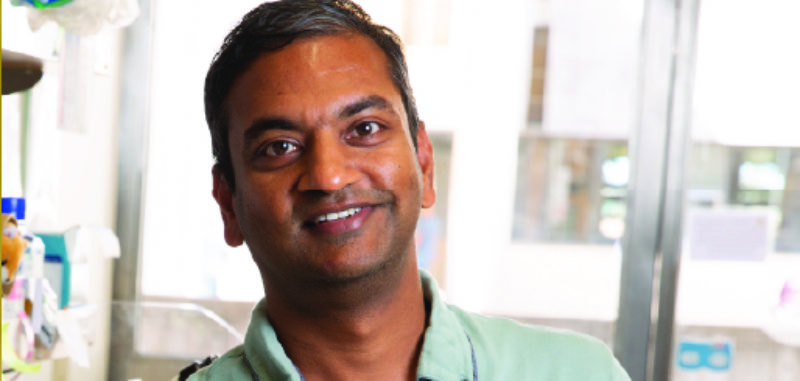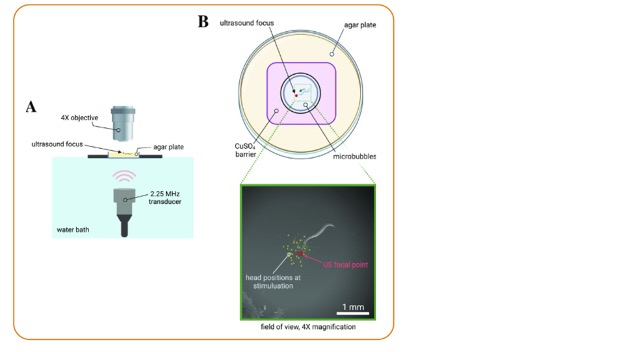
Stories

Photo courtesy of Sreekanth Chalasani
Sreekanth Chalasani: Novel Breakthroughs for the Complex Brain
2012 Rita Allen Scholar Sreekanth Chalasani first became interested in science as a child growing up in India. He was keenly aware of the world around him—when it would rain, he would wait for the earthworms and critters that come out after the storms to emerge, and he loved observing spiders and butterflies.
Although Chalasani still holds a passion for nature’s fauna, he recalls one moment in the 10th grade that diverted his attention from animal biology to human biology. “I read a story about the world’s first gene therapy patient,” he recalls. “She was a child who didn’t have an enzyme to make mature immune cells. The standard of care at the time was to give her blood transfusions every three months. Instead, two scientists decided to fix her cells so that they would make that enzyme. It worked! And it changed her life, and my life.” Chalasani resolved to solve biological problems that can change patients’ lives.
Chalasani attended Osmania University in India’s Telangana State, where he studied genetics, zoology, and chemistry, blending his love of the natural world and human biology. His eagerness at the outset of his undergraduate studies was momentarily dimmed by a lab experiment during his first few weeks that did not go exactly as planned. “It was terrible. I was trying to look at cells on a coverslip using a microscope. The instructor said, ‘Okay, Shrek, why don’t you look at these and tell me how many red blood cells and white blood cells you have?’ It was a very simple experiment. I took the slide with the coverslip, stuck it in the microscope, and broke the slide. I also broke the objective. The instructor said, ‘Shrek, you just broke everything. Nobody else can do any experiments from now on!’”
Despite his instructor’s response, Chalasani persevered with his studies and is now able to reflect on that experience and how it has influenced him as a mentor. “What I learned is that it’s okay to make mistakes. People make mistakes all the time, and as long as you learn from them, that’s okay.”
Chalasani didn’t let that early setback deter him and graduated with a B.S. and an advanced diploma in computer science. After graduating, he found a position working in a lab at the National Center for Biological Sciences in Bangalore. Around this time, a conference recognizing the 100-year anniversary of the discovery of the malarial parasite also took place at his institution. At this event, he met David S. Roos, a researcher from the University of Pennsylvania, who convinced Chalasani to continue his education and go to graduate school. He remembers, “I didn’t know anything about grad school, I was happy doing my research—but [with the encouragement from Professor Roos] I applied to grad school, and joined him at Penn. In fact, I did two rotations in David’s lab. I also worked with another mentor, who is like my American dad now. His name is Jonathan Raper.”
In the Raper lab, Chalasani studied how the brain is assembled by characterizing the cues that guide growing axons—thin fibers that connect nerve cells and transmit electrical impulses—to their targets in the developing nervous systems of mice and fish. He saw the value of studying the brain in healthy organisms to understand what happens during disease. “[At that time] I realized that mice and fish brains are really complex, and trying to understand how they work is very difficult,” explains Chalasani.
After he completed his doctorate, Chalasani attended the University of California, San Francisco and The Rockefeller University for this postdoctoral training, where he was introduced to soil-dwelling nematode worms (Caenorhabditis elegans)—a much simpler organism with only 302 neurons. Each neuron in the worm’s nervous system has been mapped and identified, which makes it possible to understand the function of each of its neural circuits, a much more challenging task in fish or mice, which have hundreds of thousands to millions of neurons.
Chalasani is currently a professor in the Molecular Neurobiology Lab at the Salk Institute for Biological Studies, where he started his lab in 2010. The Chalasani lab has several projects focused on understanding how the healthy brain works. They use animal models from simple worms to more complex mice to make discoveries about how the human brain functions. Despite its simple nervous system, the nematode worm shares some genes, molecular mechanisms, and even behaviors with humans. The Chalasani lab explores how the brain processes emotions such as aggression and fear, and even more complicated questions, such as how environmental or genetic changes are linked to disorders like autism spectrum disorder or depression. “We have been using C. elegans to study how genes that are associated with autism in humans alter animal behavior or physiology.” Notably, autism spectrum disorder has hundreds of genes associated with it, but we don’t fully understand how alterations in those genes can affect complex social behavior.
“However, we think that there might be a way of solving this problem, because the brain has many ways of doing a task. By taking the human genes that are associated with autism, and sticking those genes in nematodes, we can study how the nematodes have changed and try to repair [the genes] or revert them to normal behavior,” explains Chalasani.
Looking back, Chalasani remembers that the process of becoming a Rita Allen Scholar was not easy. “The interview was pretty challenging,” he recalls. The Scientific Advisory Committee had clearly read his work very carefully and had a lot of questions about his proposal, but Chalasani welcomed the challenge.
With the Rita Allen Scholar funding, Chalasani planned to study the cellular and molecular processes that lead to changes in behavior across multiple neuronal circuits and different timescales in the nematode C. elegans. However, consistent with his creativity and ability to work across multiple fields, he ended up taking his work in a new direction. “Midway into [the grant], I switched the project. I had this harebrained idea that I could use ultrasound to manipulate cells.” This new technique, sonogenetics, would allow the team to manipulate neurons non-invasively. This technique may be used to manipulate specific brain regions and mitigate symptoms associated with neuronal conditions. Chalasani saw the potential value of sonogenetics for patients. “If someone has a diagnosis of Parkinson’s disease, [the current treatment] using deep brain stimulation is to drill a hole in their skull and stick an electrode all the way down to a deep part of the brain. Then, we shock that part of the brain, so it produces dopamine, controlling their tremors. This is a highly invasive procedure that doesn’t always improve the quality of life of the individual.”
“What if you could [achieve the same result] without doing all that surgery? We have discovered proteins that respond to ultrasound. You stick this protein in any cell in the body that you want to control, and then you attach an ultrasound transducer outside the body. The transducer generates a sound wave, which specifically controls the cells expressing the ultrasound-sensitive protein. So, it’s like a remote control without surgery.” Chalasani’s team spent the last three years of the Rita Allen Award developing the technique, which they are now testing in mice. “To get to a human, we must test it in mice first, which we are doing currently, and then in other models. Hopefully, in a couple of years, we’ll be able to do human research trials.”

Here, Chalasani shares his insights on his most significant research achievements, overcoming challenges in his career, and what he likes to do outside of the lab.
What would you say are your most significant research achievements to date?
Every person who has worked in my lab has done well, not only in my lab but also after they have left. To know that I might have played a small role in helping them achieve their objectives is exciting and makes me very proud of what we are up to. I think mentorship is the most important thing for a scientist, in my mind. Science has this tradition that you train somebody, and that person trains other people. There is this unbroken chain of mentorship and training. I’m part of that chain, and that’s critical to who I am as a person.
What are some of the biggest challenges you have had with regard to your research, and what have you done to address those challenges?
Identifying the right person for your lab is usually the biggest challenge. It’s easier to get money. Ideas are a dime a dozen. There are lots of ideas floating around. But it’s the people who are executing those ideas, and it’s the people who you must supervise, train, mentor, and manage.
What are some of your passions or interests outside of the lab?
I try to do something new every year. A few years ago, I learned swing dancing for a year. Then, I learned pottery and swam during other years. I have been learning guitar for the past few years. This year, I’m learning Spanish on Duolingo.